A few months back a friend of mine, Mike (you may know him as the mad fermentationist), asked if I wanted to assist him in writing an article for Brew Your Own magazine (BYO) about homebrewing with Lactobacillus (here is the table of contents for that issue). After going back and forth a few times, we decided that it would be fun to do an experiment with different species of Lactobacillus available to the homebrewer rather than just a article with advice and information. Feel free to buy the issue of that magazine that has the article, there is additional information in there that I am not including in this post. I am only going to cover the experimental portion of the article here. I am not going to go over Lactobacillus physiology in great detail here, only as it pertains to this experiment in particular. For an article about Lactobacillus physiology, please read the “Physiology of Flavors in Beer – Lactobacillus“. There will also be additional Lactobacillus posts in the future on this blog, two are already in progress.
A quick disclaimer about this experiment. Like all experiments, the setup exists in a pretty narrow context. I decided to test, as best I could, the effect of 4 different Lactobacillus species as they are available to the homebrewer from different yeast labs. I ultimately decided on L. buchneri (from WYeast), L. brevis (from White Labs), L. delbrueckii (from White Labs), and L. plantarum (provided as a pure culture from Omega Labs). Like all good experiments, I will refrain from drawing any sweeping conclusions from such a simple and small study. If you don’t like or disagree with my results…leave a comment below and we can try and figure out together how we could have gotten different results. I will do my best to explain the relevant variables for this experiment but I will surely leave something out.
The goal of this experiment is to better understand how different Lactobacillus species behave during solo-fermentations. I thought the best way to do this would be to measure the drop in pH produced by the most common Lactobacillus species available to homebrewers. The four species we selected were L. buchneri (Wyeast WY5335), L. brevis (White Labs WLP672), L. delbrueckii (White Labs WLP677), and L. plantarum (one of the species from Omega Labs OYL-605 Lactobacillus Blend). Cells were grown in anaerobic starter cultures and an equal amount of cells (~109 ) were inoculated into unhopped wort with an original gravity of 1.040 and placed at 86°, 99°, 102°, and 108° F (30°, 37°, 39°, and 42° C). The pH was measured at intervals over the course of several days by placing a sanitized pH probe into the flasks containing the cells. The growth conditions were microaerophilic (I couldn’t strictly do anaerobic and take as many readings. So that’s the set up. Any questions so far? I’m sure I’m forgetting some important variables.


Results
The pH of the wort was measured at different times over the course of several days for each of the organisms at different temperatures. Here are the raw results for each temperature. The measured values are presented in tables (raw data) and in graphs of pH vs. time for each organism at each temperature. While all organisms experienced a drop in pH from a starting point of 5.9, the greatest drop was seen in Lactobacillus plantarum followed closely by Lactobacillus brevis. More analysis in the conclusions section.
CELLS GROWN AT 86 °F
| Time | Lactobacillus buchneri | Lactobacillus brevis | Lactobacillus delbrueckii | Lactobacillus plantarum |
| 0 | 5.9 | 5.9 | 5.9 | 5.9 |
| 6 | 5.57 | 5.13 | 5.59 | 4.81 |
| 18 | 4.4 | 3.94 | 4.62 | 3.6 |
| 24 | 4.2 | 3.78 | 4.6 | 3.45 |
| 75.5 | 3.88 | 3.44 | 4.46 | 3.27 |
| 120 | 3.85 | 3.4 | 4.4 | 3.25 |
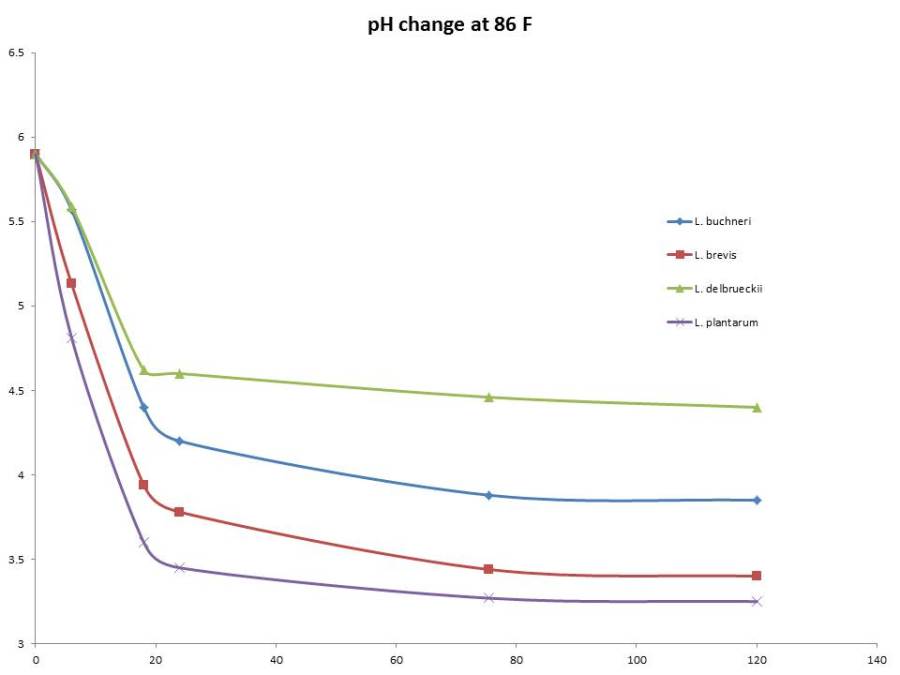
CELLS GROWN AT 98 °F
| Time | Lactobacillus buchneri | Lactobacillus brevis | Lactobacillus delbrueckii | Lactobacillus plantarum |
| 0 | 5.9 | 5.9 | 5.9 | 5.9 |
| 6 | 5.61 | 5.05 | 5.55 | 5.02 |
| 18 | 4.15 | 3.74 | 4.54 | 3.22 |
| 24 | 4.05 | 3.67 | 4.54 | 3.2 |
| 75.5 | 3.5 | 3.31 | 4.32 | 3.22 |
| 120 | 3.5 | 3.29 | 4.3 | 3.21 |
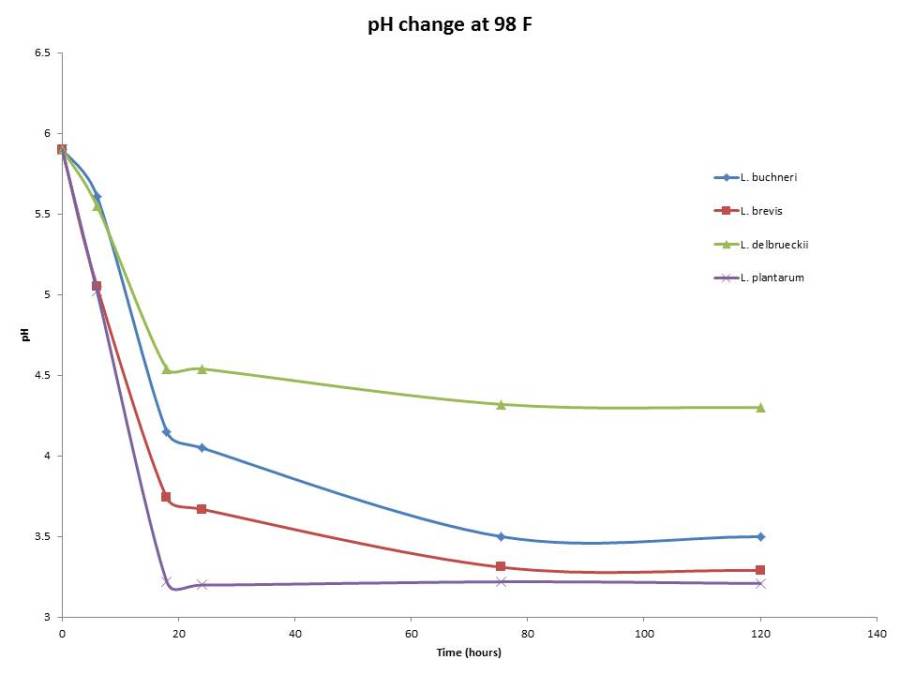
CELLS GROWN AT 102 °F
| Time | Lactobacillus buchneri | Lactobacillus brevis | Lactobacillus delbrueckii | Lactobacillus plantarum |
| 0 | 5.9 | 5.9 | 5.9 | 5.9 |
| 6 | 5.45 | 5.02 | 5.5 | 5.11 |
| 18 | 4.13 | 3.73 | 4.61 | 3.4 |
| 24 | 4.06 | 3.6 | 4.58 | 3.29 |
| 75.5 | 3.72 | 3.33 | 4.47 | 3.23 |
| 120 | 3.68 | 3.3 | 4.4 | 3.2 |
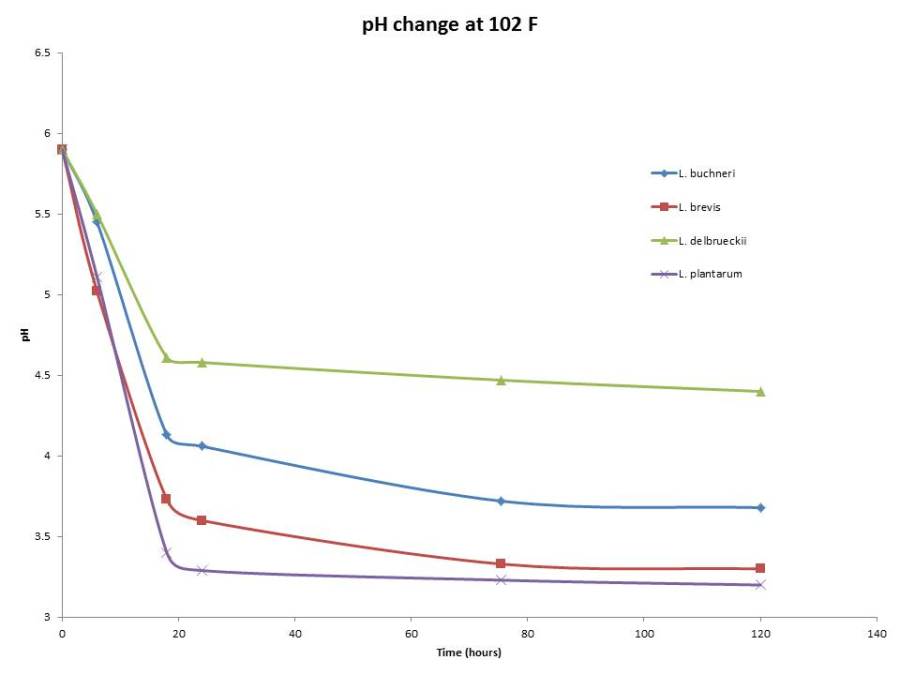
CELLS GROWN AT 108 °F
| Time | Lactobacillus buchneri | Lactobacillus brevis | Lactobacillus delbrueckii | Lactobacillus plantarum |
| 0 | 5.9 | 5.9 | 5.9 | 5.9 |
| 6 | 5.6 | 4.95 | 5.51 | 4.99 |
| 18 | 4.49 | 3.71 | 4.8 | 3.54 |
| 24 | 4.37 | 3.52 | 4.6 | 3.45 |
| 75.5 | 4.33 | 3.35 | 4.62 | 3.34 |
| 120 | 4.29 | 3.3 | 4.51 | 3.3 |
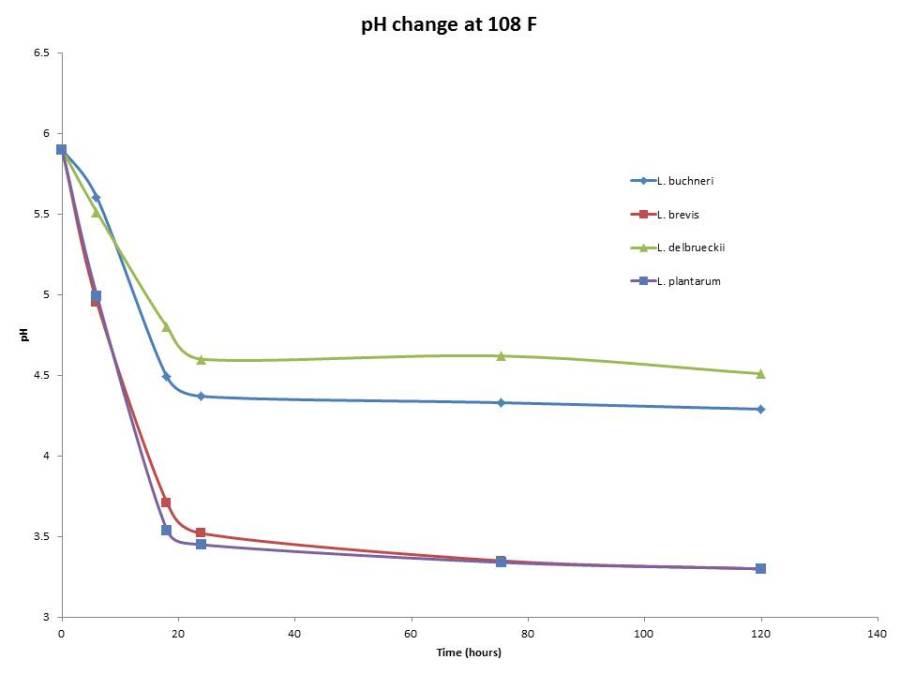
Conclusions
This experiment was done in replicate but the data presented here is just one of the samples, both samples clustered well with the pH and there was nearly no drift in the readings. I cannot do statistics on this experiment.
So overall, the Lactobacillus delbrueckii from White Labs was the worst performer with respect to ability to drop the pH at any tested temperature for the allotted time. The temperature didn’t seem to have a great effect on L. brevis or L. plantarum…both of those species were able to drop the pH quickly and bottomed out below 3.4.
The L. buchneri was able to drop the pH almost as low as the L. brevis and the L. plantarum at 98 F but displayed a temperature sensitivity above 102 F, the wort ended at a relatively high pH.
The overall conclusion of this test is that if the desired effect is a quick drop in pH to 3.5 or lower, I would recommend you use the OMEGA Lacto blend with the L. plantarum in it or the L. brevis from White Labs. I’ve had good results with both of these products making some great sour beers. There are obviously other Lactobacillus species and sources available to the homebrewer (some people even buy those over the counter probiotic pills and use those in starter wort)….and I’d love to test them all this way but for the limited scope of this post, I think this is a good starting point.
Follow-ups and additional experiments
So measuring pH is only one dimension, I did not measure total acidity or titratable acidity. I also didn’t measure the gravity (although the drop in gravity would be pretty small in each of these cases), I also didn’t taste the different cultures (I had put an antibiotic in there to inhibit yeast growth and that made the samples toxic to humans). So there are a lot of things I can do as follow up.
First, I’d like to add another culture. After doing this experiment I received some Lactobacillus rhamnosus from RVA yeasts. It would be great to redo this with another organism, more data is always better. Second, I’d love to make “single” fermentation with each of the these species in isolation, finish the fermentation out with some Saccharomyces and then see if there is a taste difference from the secondary metabolites I covered in my “Physiology of Flavors” post. Lastly, I’m going to measure the hop tolerance of all of these species to see where they bottom out. I may throw in a Pediococcus in there for that one.
Final Thoughts
I believe the goal of any homebrewer is how to create a specific flavor profile. The goal of this blog (and me in the brewing community) is to do some thoughtful tests of claims made by people providing resources to brewers. I don’t consider myself an authority on Lactobacillus fermentation (far from it) but I think this data is accurate and for the purpose of informing the brewing community I think this data is quite valuable. I’m not suggesting people not use the White Labs Lactobacillus delbrueckii…I’m just presenting, in my hand, for this experiment, what I observed. If it works for you…great. I’d love feedback on the experimental design, setup and execution from anyone willing. The goal is more information to increase our understanding.
“The initiation of the fermentation process does not require so complicated an apparatus as is represented by the living cell. The agent responsible for the fermenting action of the press juice is rather to be regarded as a dissolved substance, doubtless a protein; this will be denoted zymase.” — Eduard Buchner
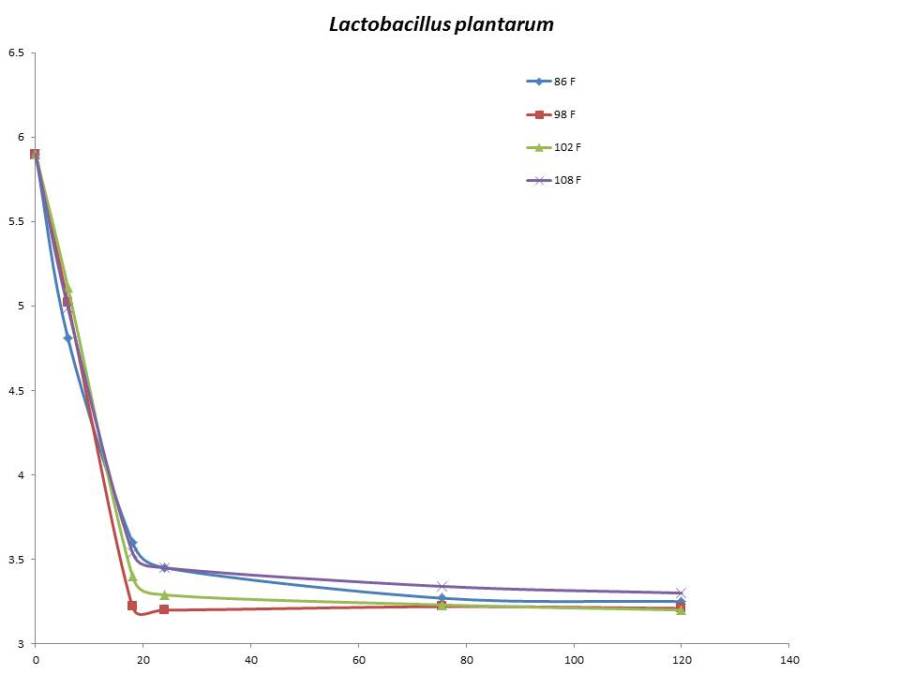
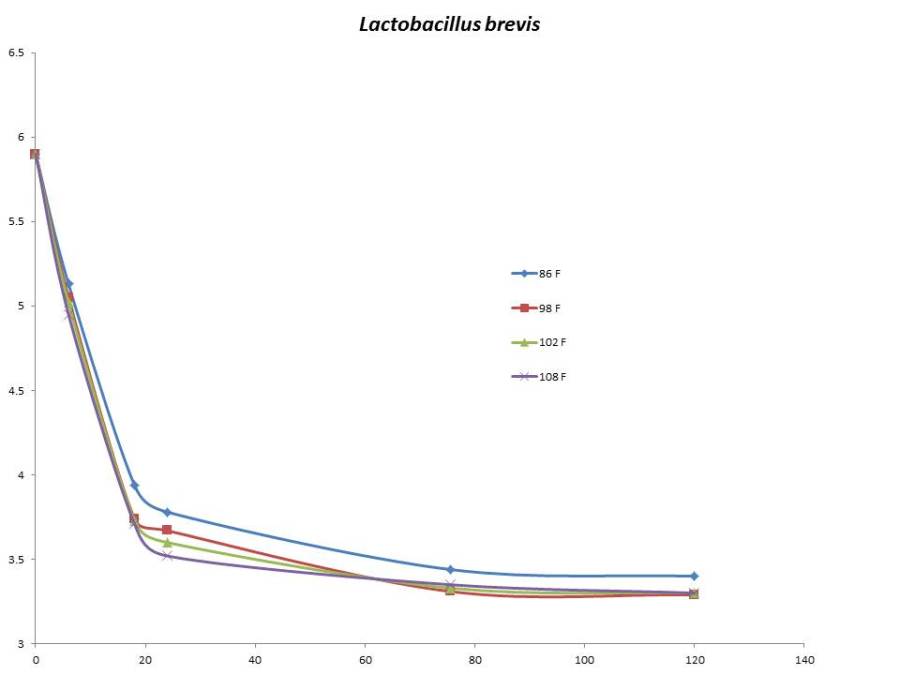
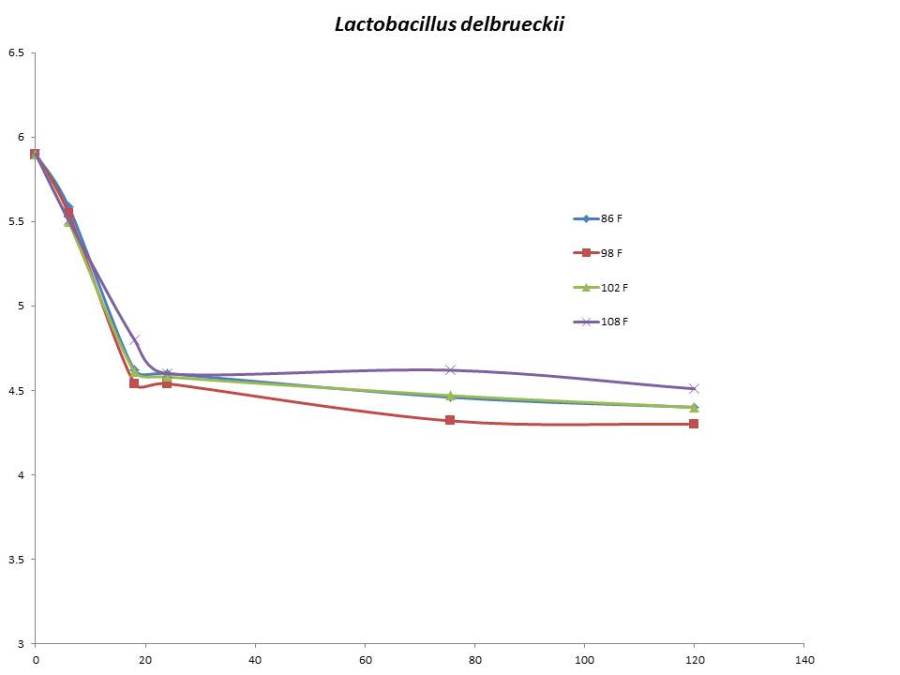
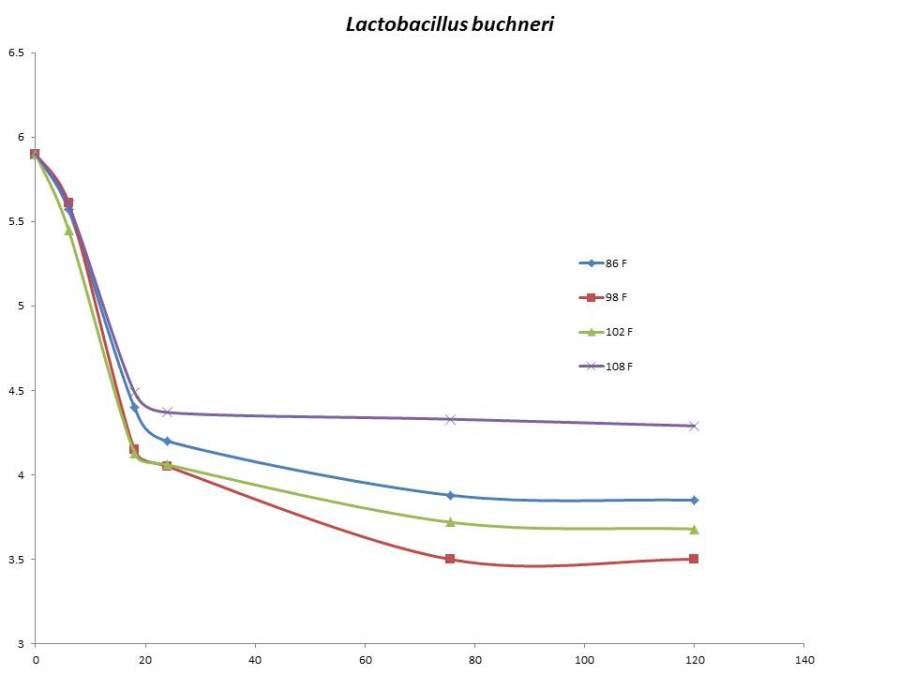
Awesome stuff, thanks for sharing!! Looking forward to your follow-ups.
Have you considered measuring the effect of oxygen in the samples as another experiment? Say by introducing O2 directly and maybe putting it on a stir plate. Might be interesting to see how flavor is affected due to potentially acetic acid or whatever else, and the effect on pH and SG drop.
Cheers!
Great post! Everything I read makes me want to try L. planitarum – my experience with the other commercial lacto’s mirror’s your results here. I’ve got a Gose coming up in September; L.P. going to do the heavy lifting!
Great stuff! Just curious, did you include an untreated control? Would be interesting…
Also, what is the water chemistry like that you used? Would play a role I think…
Thanks for posting this and organizing/running these experiments.
I’d be very interested to see the follow up experiment where titratable acidity is measured. I’ve read that titratable acidity reflects our taste perception of sourness better than pH, is that true?
I’ve heard that as well but like all things it is a partial truth. pH is a good short answer to how sour something will taste.
Great article about fermetation and acidification of beer wort. I am currently doing a similar work with another lactobacillus strain.
How about the aditional lactobacillus rhamnosus, did you do a similar experiment with it?